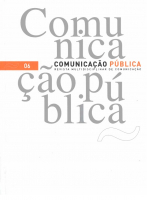Mediation in new labour’s modernization of government
a critical discourse analysis perspective
DOI:
https://doi.org/10.4000/cp.7883Resumo
The concept of ‘mediation’ is tied to overcoming distance in communication, communicating with ‘distant others’. Mediation is associated with ‘time- -space distanciation’, the ‘detachment of a symbolic form from its context of production’ and its ‘re-embedding in new contexts which may be located at different times and places’ (Thompson 1995: 21). Modern forms of telecommunication (the telegraph and telephone, then radio, television, and then the internet) have resulted in the ‘uncoupling of space and time’ (Thompson 1995: 32), in the sense that communication with ‘distant others’ is no longer subject to the delays resulting from the need to physically transport symbolic forms (eg letters or printed material). Changes in information and communication technologies and the emergence of new media have vastly expanded the possibilities for overcoming distance in communication, making possible instantaneous communication over unlimited distances at little cost, and they are generally regarded as a crucial element of contemporary processes of globalization.
Downloads
Referências
Bernstein, B. (1990). The structuring of pedagogic discourse. Routledge. DOI : 10.4324/9780203011263
Chouliaraki, L. & Fairclough, N. (1999). Discourse in late modernity. Edinburgh University Press.
Fairclough, N. (1992). Discourse and social change. Polity Press.
Fairclough, N. (1995). Media discourse. Edward Arnold.
Fairclough, N. (1998). «Political discourse in the media: an analytical framework». In: A. Bell & P. Garrett (eds) Approaches to media discourse blackwell (pp.142-162).
Fairclough, N. (2000). New labour, new language. Routledge. DOI : 10.4324/9780203131657
Fairclough, N. (2000). «Discourse, social theory and social research: the discourse of welfare reform», Journal of Sociolinguistics, 4(2).
Fairclough, N. (2003). Analyzing discourse: Text analysis for social research. Routledge.
Fairclough, N. (2005). «Blair’s contribution to elaborating a new doctrine of ‘international community’». Journal of Language and Politics, 4(1) 41-63.
Fairclough, N. (2005). «Critical discourse analysis». Marges Linguistiques, 9, 76-94. DOI : 10.4324/9781315834368
Fairclough, N. (2006). «Semiosis, mediation and ideology: a dialectical view». In: I. Lassen, J. Strunck & T. Vestergaard (eds) Mediating ideology in text and image: Ten Critical Studies John Benjamins (pp. 19-35).
Fairclough, N. (2006). Language and globalization. Routledge. DOI : 10.1515/SEMI.2009.014
Fairclough, N., Jessop B. & Sayer A. (2004). «Critical realism and semiosis» (revised version). In: J. Joseph & J. Roberts (eds) Realism, discourse and deconstruction. Routledge.
Hall, S. (2003). «New labour’s double-shuffle». Soundings, 24. DOI : 10.1080/10714410500338907
Silverstone, R. (1999). Why study the media?. Sage.
Thompson, J. (1995). The media and modernity. Polity Press.
Tomlinson, J. (1999). Globalization and culture. Polity Press.
van Ginneken, J. (1998). Understanding global news: A critical introduction. Sage.
Downloads
Publicado
Edição
Secção
Licença
Direitos de Autor (c) 2008 Copyright (c) 2008 Author

Este trabalho encontra-se publicado com a Licença Internacional Creative Commons Atribuição-NãoComercial 4.0.
Os conteúdos da Comunicação Pública estão licenciados com uma licença Creative Commons - Atribuição-NãoComercial 4.0 Internacional.




